General Information
| General Service Information |
Protection of the Vehicle
Always be sure to cover fenders, seats, and floor areas
prior to beginning work.
| • |
The support rod must
be inserted into the hole near the edge of the hood whenever you
inspect the engine compartment to prevent the hood from falling
and causing possible injury. |
| • |
Make sure that the support
rod has been released prior to closing the hood. Always make sure
the hood is firmly latched before driving the vehicle. |
|
Preparation of Tools and Measuring Equipment
Make sure that all necessary tools
and measuring equipment are available prior to beginning work.
Special Tools
Use special tools when they are required.
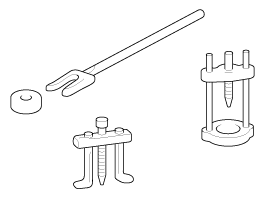
Removal of Parts
First find the cause of the problem and then determine whether
removal of disassembly is needed before starting the job.
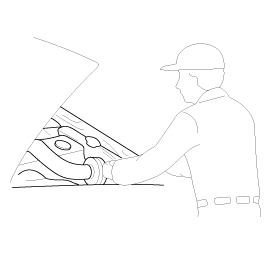
Disassembly
If the disassembly procedure is so complex that it requires many parts
to be disassembled, all parts should be disassembled in a way that will not affect
their performance or external appearance.
| 1. |
Inspection of parts Each part,
when removed, should be carefully inspected for malfunction, deformation,
damage, and other problems.
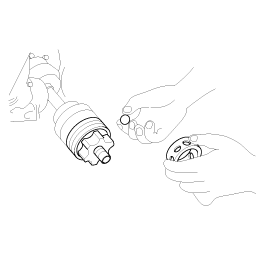
|
| 2. |
Arrangement of parts All disassembled
parts should be carefully arranged for effective reassembly.
Be sure to separate and distinguish the parts to be replaced from those
that will be used again.
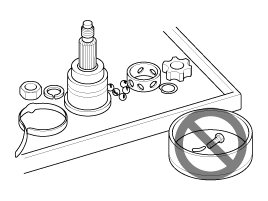
|
| 3. |
Cleaning parts for reuse All
parts to be used again should be carefully and thoroughly cleaned in an
appropriate method.
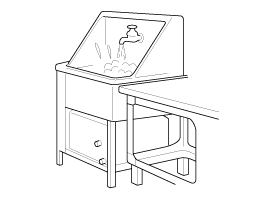
|
Parts
When replacing parts, use HYUNDAI genuine parts.
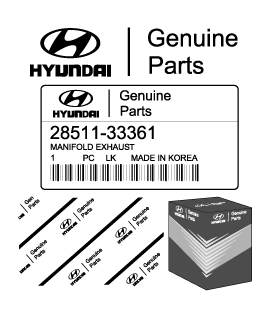
Replacement
Standard values, such as torques and certain adjustments, must be
strictly observed in the reassembly of all parts.
If removed, the following parts should always be replaced with new ones.
| 5. |
Cotter pins (split pins) |
| 6. |
Plastic nuts
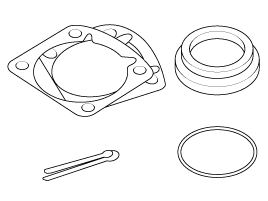
Depending on their location. |
| 7. |
Sealant should be applied to
gaskets. |
| 8. |
Oil should be applied to the
moving components of parts. |
| 9. |
Specified oil or grease should
be applied to the prescribed locations (oil seals, etc.) before assembly.
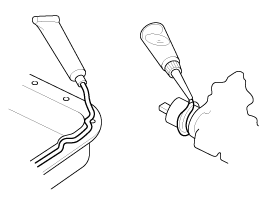
|
Adjustment
Use gauges and testers to adjust correctly the parts to standard values.
Electrical System
| 1. |
Be sure to disconnect the battery
cable from the negative (-) terminal of the battery. |
| 2. |
Never pull on the wires when
disconnecting connectors. |
| 3. |
Locking connectors will click
when the connector is secure. |
| 4. |
Handle sensors and relays carefully.
Be careful not to drop them against other parts.

|
Rubber Parts and Tubes
Always prevent gasoline or oil from contacting the rubber
parts or tubes.
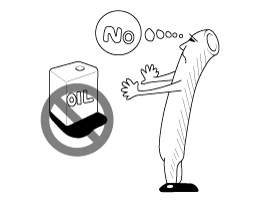
Measuring Body Dimensions
| 1. |
Basically, all measurements in
this manual are taken with a tracking gauge. |
| 2. |
When a measuring tape is used,
check to be sure there is no elongation, twisting or bending. |
| 3. |
For measuring dimensions, both
projected dimensions and actual - measurement dimensions are used in this
manual. |
Projected Dimensions
| 1. |
The dimensions are measured by
projecting the measurement points on the vehicle surface onto the reference
dimensions. |
| 2. |
If the length of the tracking
gauge proves is adjustable, measure the dimensions by lengthening one of
the two probes to the height difference between the two measuring surfaces.
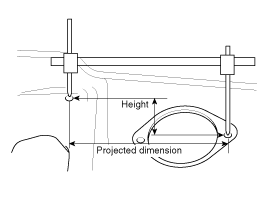
|
Measuring Actual Dimensions
| 1. |
These dimensions indicate the
actual linear distance between measurement points, and are used as the reference
dimensions when a tracking gauge is used for measurement. |
| 2. |
First adjust both probes to the
same length (A=A') before measurement.
| •
|
Check the probes
and gauge to make sure there is no free play. |
|
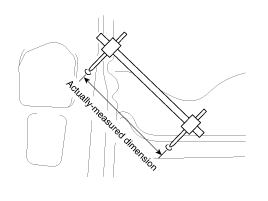
|
Measurement Point
Measurements should be taken at the center of the hole.
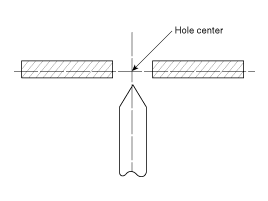
Checking Cables and Wires
| 1. |
Check the terminal for tightness. |
| 2. |
Check terminals and wires for
corrosion from battery electrolyte, etc. |
| 3. |
Check terminals and wires for
open circuits. |
| 4. |
Check wire insulation and coating
for damage, cracks and degrading. |
| 5. |
Check whether the conductive
parts of terminals contact other metallic parts (vehicle body and other
parts). |
| 6. |
Check whether there is complete
continuity between the attaching bolt(s) of the grounded parts and the vehicle’s
body. |
| 7. |
Check for incorrect wiring. |
| 8. |
Check the wiring is clamped to
prevent contact with sharp corners of the vehicle body, or hot parts (exhaust
manifold, pipe, etc.) |
| 9. |
Check that the wiring is clamped
firmly to provide enough clearance from the fan pulley, fan belt and other
rotating or moving parts. |
| 10. |
Check that the wiring has a little
space so that it can vibrate between the fixed (the vehicle body) and moving
parts (wirings, engine, etc.)
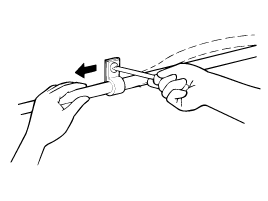
|
Checking Fuses
A blade-type fuse has test taps which enable checking the fuse
without removing the fuse from the fuse box. The fuse is in good state if the test
lamp lights up when one lead is connected to the test taps (one at a time) and the
other lead is grounded. (Turn the ignition switch so that the fuse circuit becomes
operative)
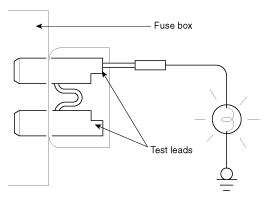
Servicing the Electrical System
| 1. |
Prior to servicing the electrical
system, make sure to turn off the ignition switch and disconnect the battery
ground cable.
| •
|
In the course
of MFI or ELC system diagnosis, when the battery cable is
removed, any diagnostic trouble code retained by the computer
will be cleared. There fore, if necessary, record the diagnostic
data before removing the battery cable. |
|

|
| 2. |
Fix the wiring harnesses with
clamps so that there is no slack wiring. However, for any harness which
passes the engine or other vibrating parts of the vehicle, allow some slack
within a range that does not allow the engine vibrations to cause the harness
to come into contact with any of the surrounding parts and then secure the
harness by using a clamp.
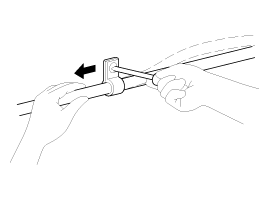
|
| 3. |
If any section of a wiring harness
interferes with the edge of a part, or a corner, wrap the section of the
harness with tape or something similar in order to protect it from damage.
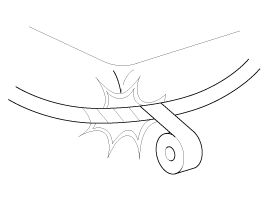
|
| 4. |
When installing any parts, be
careful not to pinch or damage any of the wiring harness.
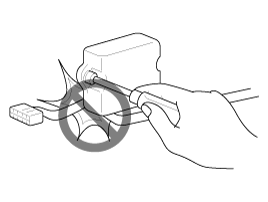
|
| 5. |
Never throw relays, sensors or
electrical parts, or expose them to strong shock.
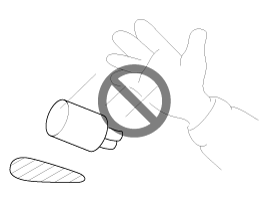
|
| 6. |
The electronic parts used in
the computer, relays, etc. are easily damaged by heat. If there is a need
for service operations that may cause the temperature to exceed 80°C (176°F),
remove the electronic parts beforehand.
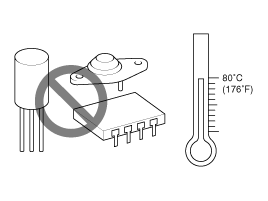
|
| 7. |
Loose connectors may cause malfunction.
Make sure that the connectors are always securely fastened.
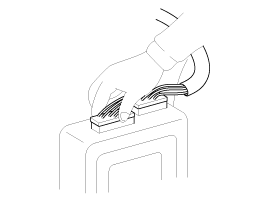
|
| 8. |
When disconnecting a connector,
be sure to grip only the connector, not the wires.

|
| 9. |
Disconnect connectors which have
catches by pressing in the direction of the arrows shown in the illustration.
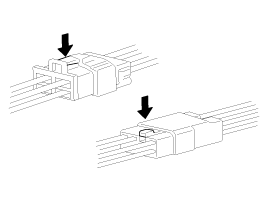
|
| 10. |
Connect connectors which have
catches by inserting the connectors until they make a clicking sound.
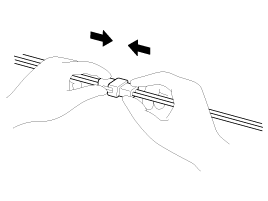
|
| 11. |
When using a circuit tester to
check continuity or voltage on connector terminals, insert the test probe
into the harness side. If the connector is a sealed connector, insert the
test probe through the hole in the rubber cap until the probe contacts the
terminal, being careful not to damage the insulation of the wires.
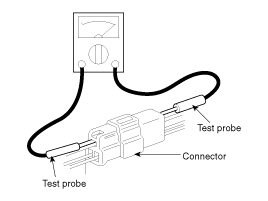
|
| 12. |
To avoid overloading the wiring,
take into consideration the electrical current load of the optional equipment
when determining the appropriate wire size.
Recommended size
|
SAE gauge No.
|
Permissible current
|
In engine compartment
|
Other areas
|
0.3mm?
|
AWG 22
|
-
|
5A
|
0.5mm?
|
AWG 20
|
7A
|
13A
|
0.85mm?
|
AWG 18
|
9A
|
17A
|
1.25mm?
|
AWG 16
|
12A
|
22A
|
2.0mm?
|
AWG 14
|
16A
|
30A
|
3.0mm?
|
AWG 12
|
21A
|
40A
|
5.0mm?
|
AWG 10
|
31A
|
54A
|
|
Precautions for Catalytic Converter
| • |
If a large amount of
unburned gasoline flows into the converter, it may overheat and
create a fire hazard. To prevent this, observe the following precautions
and explain them to customers. |
|
| 1. |
Use only unleaded gasoline. |
| 2. |
Do not run the engine while the
car is at rest for a long time. Avoid running the engine at fast idle for
more than 10minutes and at idle speed for more than 20 minutes. |
| 3. |
Do not measure engine compression
for an extended time. Engine compression tests must be made as rapidly as
possible. Remove the fuel pump relay before performing a compression test. |
| 4. |
Do not dispose of used catalytic
converter together with parts contaminated with gasoline or oil. |
General Information
Basic Service Symbols
There are five primary symbols used to complement illustrations. These symbols indicated
the materials to be applied to parts during service ...
 Hyundai Elantra AD: General Service Information
Hyundai Elantra AD: General Service Information





























